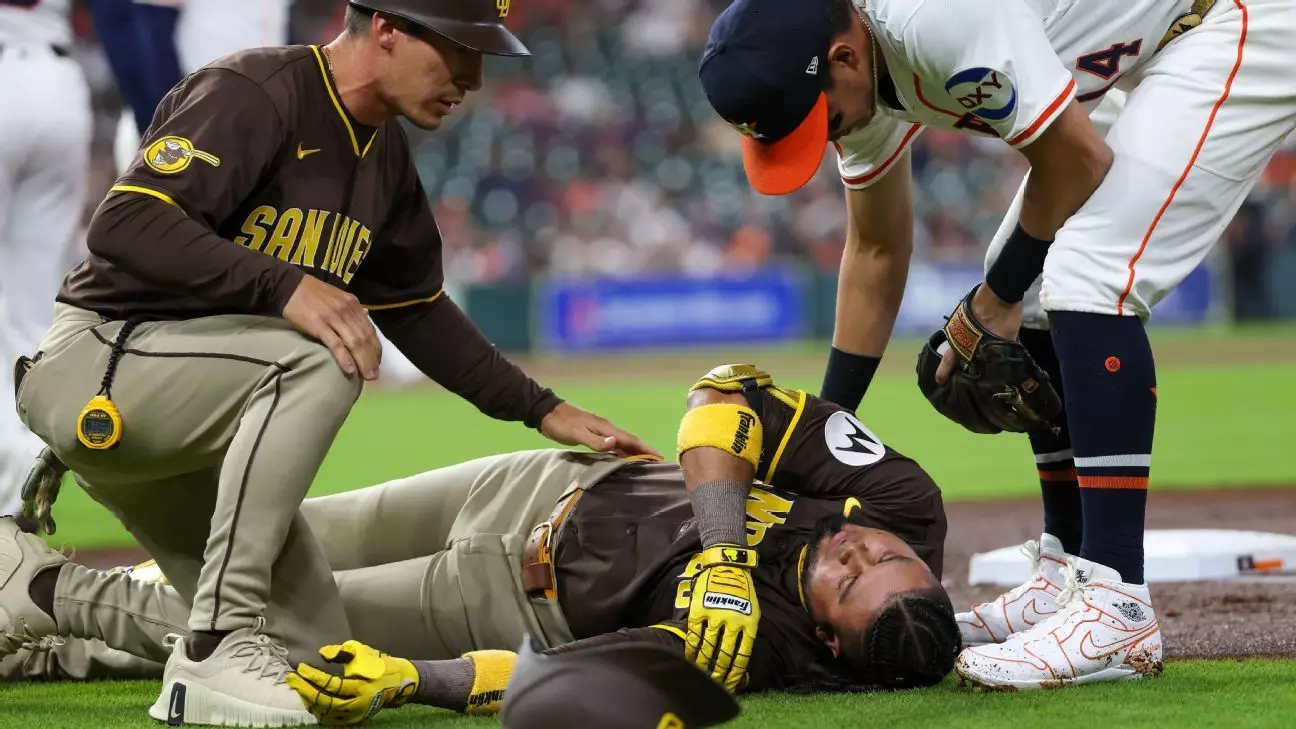In the realm of sports, where the thrill of competition frequently dances on the precipice of danger, moments like the one experienced by Luis Arraez serve as stark reminders of the inherent risks involved. Arraez, the San Diego Padres’ three-time batting champion, faced a terrifying ordeal during a recent game against the Houston Astros. In an unfortunate collision with Astros second baseman Mauricio Dubon at first base, Arraez sustained a head injury that led to his placement on the seven-day concussion injured list. The images of him being carted off and strapped to a backboard evoke an immediate sense of vulnerability, reminding fans and players alike of the fragile nature of physical prowess.
The incident unfolded in a high-pressure moment during the first inning when Arraez executed a drag bunt, a maneuver that is as deft as it is strategic. However, this seemingly routine play turned chaotic when Dubon, attempting to cover first base, collided with Arraez, resulting in a jarring impact that left the latter momentarily motionless. The sight was alarming—not just for fans but for everyone involved on the field. It poses an important question about the safety protocols in sports and the emotional toll such injuries can have on teammates, opponents, and spectators alike.
Heartfelt Reactions: A Community’s Concern
The aftermath of the collision brought forth heartfelt reactions from both players and coaches. Padres manager Mike Shildt expressed a palpable mix of relief and concern following the incident. His acknowledgment of the anxious atmosphere surrounding Arraez’s injury underscores how deeply interconnected the world of sports can be, where players experience not just individual triumphs but also collective tribulations. Shildt’s comments about the overall positive outlook, given the ugly nature of the incident, speaks volumes about the camaraderie that exists in the sport.
Dubon’s candid reflections on the emotional strain he felt highlight the human aspect often overshadowed by fierce competition. His declaration of being a “not a dirty player,” coupled with his vulnerability in facing threats over what transpired, reveals an often-ignored dimension of athlete psychology—a desire to honor the game while navigating its brutal realities. It serves as a reminder that even the fiercest competitors share a bond forged under the pressures of the game, something that transcends team lines.
The Power of Community Support
As players from both teams rallied around Arraez during this difficult time, it showcased how sports can sometimes foster empathy and community. The sight of stars like Fernando Tatis Jr. and Manny Machado visibly shaken by the ordeal is illustrative of the profound connections that form within the league. Sportsmanship, often tainted by rivalry, was put on stark display as they prayed for Arraez’s well-being, showing that there is life beyond the win column.
Moreover, the support extended beyond the field. Fans, the lifeblood of sports culture, often deploy their own emotional bandwidth to support injured players. The unified outpouring of concern from the fanbase indicates that true loyalty extends well beyond the statistics in the box score. Such incidents draw emotional responses from the very heart of baseball culture, reaffirming the idea that we are, above all, part of a larger community united through shared passion and respect for the game.
The Road to Recovery: Cautious Optimism
In the days following the incident, hopes for Arraez’s swift return were bolstered by the positive reports from medical tests. It was promising to hear that no structural damage had been found and that he remained alert. This sense of cautious optimism illustrates how resilience in sports often parallels resilience in life. Through rigorous protocols and attentive care, both medical professionals and coaching staff are exemplifying how the well-being of the player will always take precedence.
As Arraez began the concussion protocol and awaited further evaluations, the conversation shifted to his replacement—infielder Mason McCoy. The decision to recall McCoy hints at the often grueling realities of roster management, showing how quickly the next man up must prepare to contribute. Yet, it also raises discussions regarding the pressures on emerging players who must seize their opportunity when it comes.
In totality, the Luis Arraez incident is more than just a moment in a game; it is a complex interweaving of vulnerability, community support, and the resilience of athletes. As he progresses through recovery, fans and teammates alike will keep their fingers crossed, galvanizing their spirits around the hope of his triumphant return to the diamond—a symbol, perhaps, of the indomitable spirit that sports encourage in all of us.

